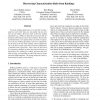Free Online Productivity Tools
i2Speak
i2Symbol
i2OCR
iTex2Img
iWeb2Print
iWeb2Shot
i2Type
iPdf2Split
iPdf2Merge
i2Bopomofo
i2Arabic
i2Style
i2Image
i2PDF
iLatex2Rtf
Sci2ools
ICMLA
2009
2009
Discovering Characterization Rules from Rankings
For many ranking applications we would like to understand not only which items are top-ranked, but also why they are top-ranked. However, many of the best ranking algorithms (e.g., SVMs) are black boxes that give little information about the factors for their rankings. We describe and demonstrate a new approach that can work in conjunction with any ranking algorithm to discover explanations for the items at the top of the rankings. These explanations are in the form of rules expressed as boolean combinations of attribute-value expressions. These rules are discovered by contrasting attributes of items drawn from both the top and bottom of a ranking list, looking for items that have high leverage, corresponding to rules with broad coverage and sharp differentiations. We include empirical results to demonstrate the utility of our method.
Related Content
| Added | 19 Feb 2011 |
| Updated | 19 Feb 2011 |
| Type | Journal |
| Year | 2009 |
| Where | ICMLA |
| Authors | Ansaf Salleb-Aouissi, Bert C. Huang, David L. Waltz |
Comments (0)

